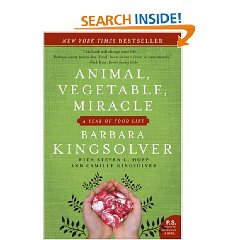This was originally posted on another blog of mine (Simplicity — Small & Cheap). I consolidated all blogs to simplify my life. – Jen 6/19/09
 I had started writing this review on my computer right after finishing the book. I was so overwhelmed by the sheer amount of knowledge I gained after reading it that I didn’t have a clue where to begin! Over the course of reading, I would stop and read parts of it to my husband that I thought he would find interesting. I think he thinks I’ve lost my mind. Not that he thinks it silly; quite the contrary. He has been an advocate of the ideas (well many of them, not all) for a long time. I just never GOT it. But now I do.
I had started writing this review on my computer right after finishing the book. I was so overwhelmed by the sheer amount of knowledge I gained after reading it that I didn’t have a clue where to begin! Over the course of reading, I would stop and read parts of it to my husband that I thought he would find interesting. I think he thinks I’ve lost my mind. Not that he thinks it silly; quite the contrary. He has been an advocate of the ideas (well many of them, not all) for a long time. I just never GOT it. But now I do.
Barbara, along with her husband, Steven and their daughters Camille & Lily moved from Arizona for a farm that Steven owned in Virginia before they were married with the intent of going back to their roots. A place where people share your name, the ground is green with food and filled with blue water that even your fish can drink :). After spending some time getting the farm back into condition, they decided to go (almost) whole hog and live on only locally grown/processed foods.
This is their story. It’s not a story of sacrifice; rather, it’s the story of reconnecting with a simpler life and understanding why feasts and harvests were celebrated.
One of the most basic (and frankly) kind of embarassing) things I learned was how to determine when something would be in season. Kingsolver gives an excellent primer on comparing the growing season life cycle as if all product were a product of a single plant — stems, leaves, flowers, berries/fruit, seed pods, roots, etc. Duh.
I also learned more about the life cycle of gardening and planting as well as raising turkeys and chickens. She reflects a lot on how being so intimate with your food gives you a different outlook on it. She also mentioned several organizations, such as Slow Food International (which I’ve heard of before) and brings you on a virtual eating tour of Italy. There is information about growing, buying and raising endangered (heirloom) varieties of plants and animals that have been almost bred out of existance because of industrialized food production.
Quite disturbingly, Barbara also shares information about chemical companies who have purchased most of the seed companies so they can control the food production. Many of them have modified the foods so that the grower must purchase their fertilizer and pesticide for best results. Also disturbing is the chemical companies genetically engineering seeds so that they geneticially explode after a year so that they need to be purchased every growing season.
Kingsolver is not preachy about trying to change your habits. She simply illustrates why her family is happier because of these choices they’ve made. Neither does she expect you to sell your townhouse and buy a farm in the boonies, living off the grid. She makes suggestions for all sorts of small steps that you can take, no matter what your lifestyle, as well as provides plenty of resources for more information.
Barbara has written this majority of this book in narrative form. Her husband Steven, expounds on some of the points, writing information essays with sources for more information on some technical/factual points she makes. Her daughter, Camille, writes her perspective on having started the experiment and then getting back to “the real world” and trying to find alternatives while away at college. All of it is great, thought provoking stuff and is an excellent, easy read. Prepare to have your life changed for the better.
